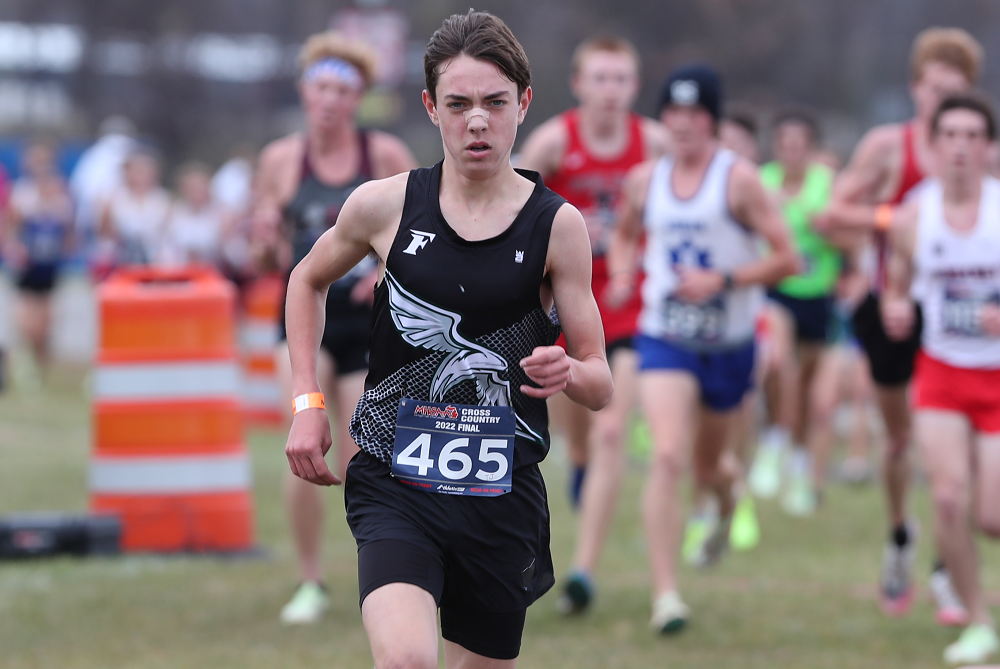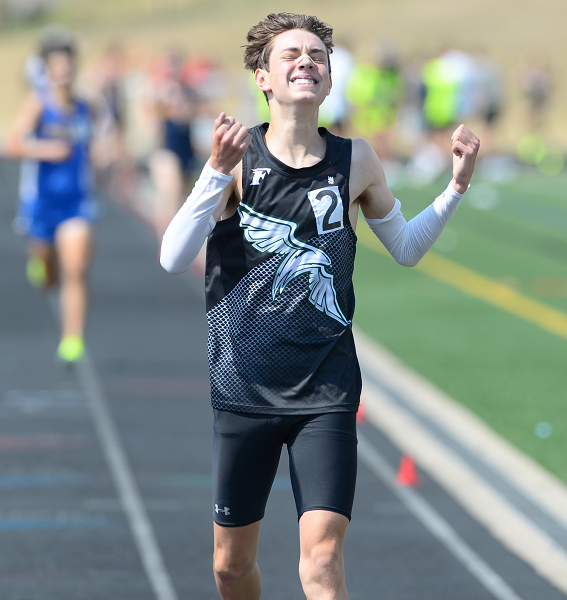
One Mora Chance To Finish On Top
November 2, 2012
Mr. Competitive got the nickname from his fourth grade teacher, and he still loves to win.
He's enjoyed that feeling more times than most over the last three years. But Connor Mora nearly made a decision that would’ve deprived the state’s cross country community of its fastest runner this season.
Soccer was a serious contender for Mora’s talents as he contemplated what fall sport to play as a freshman. Not until the end of June that summer did the now-senior decide to join Cedar Springs’ cross country team instead.
“I’ve thought about it a lot, where my life would be if I chose to play soccer. I don’t know where I’d be right now,” he said.
And the rest is history. Or can become so today.
A Second Half High 5 recipient this week, Mora will run in his fourth and final MHSAA cross country championship race at Michigan International Speedway, and is expected to lead the pack.
To answer Mora’s question, had he chosen option two, he might have just finished patrolling the Redhawks’ midfield. He was “all right” at soccer and played it through middle school. But that’s when he also decided to run cross country with some friends who were joining the team.
Great call. Fast forward to Nov. 7, 2009, when he ran a 16:23.4 at MIS. He finished 15th at the Division 2 Final and was the fastest freshman in that race. Only Lake Orion’s T.J. Carey (16:18.2) was faster among freshmen from all four divisions.
In 2010, Mora cut his Finals time to 15:39. He finished fifth in Division 2 and was the fastest sophomore in any race by five seconds.
Last season he ran a 15:33.2 at MIS, good for third in Division 2 behind two seniors. And he was again second-fastest in his grade on the day, with only Carey in Division 1 edging him by a second.
So it makes sense that Mora enters his final high school cross country race with the fastest time in the state this fall by 11 seconds after breaking the 15-minute milestone with a 14:54 at his Regional a week ago.
That time broke his personal best by 20 seconds and the Cedar Springs school record by seven.
"The exciting thing for me as a coach was being able to call off his time with maybe 200 or 300 meters to go. That’s one of my styles; I’m not at the finish line, I’m away from the finish line letting them know where they’re at,” Cedar Springs coach Ted Sabinas said. “When I called out his time, I could see he instantly knew what that meant. He had put on an amazing 800 anyway to separate himself from Clark Ruiz (of Big Rapids). When he knew he had a chance to break into the 14s, that look on his face, that effort he put in, it was something to see.”
Breaking into the 14s for a high school runner is comparable to a running back rushing for 2,000 yards or a basketball player scoring 2,000 points in a career. It’s done on occasion, but only by the very best.
Sabinas has coached cross country at the school for 28 years. He’s watched the program emerge from its beginnings to an MHSAA team title contender, and he told Mora earlier this week that he remembers vividly when his all-time top runner broke into the 16s for the first time, and then the 15s too.
But he’s become memorable for more. Mora won MHSAA track championships in the 1,600 and 800 this spring, and owns the school 1,600 record of 4:09. He’s a 3.8 student and a leader who pulled in even his youngest teammates and helped them to feel included. Mora remembers the runners who pushed him when he was a freshman, and works to supply the same influence now.
“Certainly his times stick out. But it’s his nature and his personality,” Sabinas said. “He’s a leader on the team with his actions. He leads by the way he presents himself in practice. He doesn’t take an easy day. He leads in the classroom. We’ve got a close-knit group of kids here, and he leads the way.”
That will be the goal today. Mora has finished lower than first only once this season, nearly two months ago.
“My drive to win, that’s really what drives me. I don’t want to sound full of myself or anything, but I just want to be the best,” Mora said. “I want to set an example mostly for others coming up, who are in that position, and I want to give them someone to look up to.”
PHOTO: Cedar Springs' Connor Mora (left) rounds a turn during last season's Division 2 Final at Michigan International Speedway.

Freeland's Hansen Not Focused on Joining All-Time Greats - But On His Way
By
Paul Costanzo
Special for MHSAA.com
September 29, 2023
The goal written on Matt Kaczor’s Post-It Note was sub-15 minutes, 15 seconds. That’s what the Freeland cross country coach was hoping for from star runner TJ Hansen during his junior season.
 Kaczor tore it up after seeing Hansen run a single race this fall.
Kaczor tore it up after seeing Hansen run a single race this fall.
“Knowing what he did over the summer and where he was at, seeing what his 1,600 (meter) and his mile got down to, I had a feeling he could get under 15:30 quickly,” Kaczor said. “After the first race, I looked at my assistant and was like, ‘I’ve gotta rip up that Post-It Note. I don’t think our goal is on the level of where he’s at right now.’ At first, it was break 15:15. Once I saw him race at the Under the Lights (on Aug. 18 at St. Johns), I was like, ‘Yeah, he’s going sub 15.’”
Hansen ran 15:39.6 in that first race, and on Sept. 7, in Shepherd, he ran 15:13.9 to meet the goal written on the now-shredded Post-It Note.
This past Saturday, he ran 15:03.7 at the Cadillac Veterans Serving Veterans Invitational. It’s the fastest time recorded in Michigan this year, and a signal that Kaczor might be filling out a new Post-It Note before the season is out.
“The sub-15 barrier, that’s been something on my mind for a while,” Hansen said. “Now that I’m edging closer and closer to that, it’s been exciting. With how heavy my training has been, I wouldn’t expect (to have run this fast this early). Being able to run the times I am really paints the picture for what’s ahead.”
Hansen came into the season already regarded as one of the elite distance runners in the state. He won the 3,200 meters at the MHSAA Lower Peninsula Division 2 Track & Field Finals this past spring. He’s also finished all-state (12th and fifth, respectively) the past two seasons at the LPD2 Cross Country Finals.
His current trajectory, however, would put his name near some of the state’s all-time greats. But that’s not something Hansen is focusing on.
“I really don’t like to compare myself to others,” he said. “I don’t focus on that. I try to be the best TJ Hansen that I can be. The best version of myself.”
Focusing on himself is almost necessary for Hansen, as he’s spending a lot of time during his races running by himself.
At each of the big events Freeland has run in this season, Hansen has finished at least 20 seconds ahead of his nearest competitor. That includes all divisions of the Duane Raffin Festival of Races in Holly.
In Cadillac, where Hansen ran his current best time, he was a full minute ahead of the rest of the field.
 “He’s just a special athlete,” Kaczor said. “I can’t see Freeland having someone like this in a while. He’s a generational talent. What’s crazy is, I had the school record when he was a freshman. He and Braden (Honsinger) broke it last year. But TJ has now dropped that school record (set in 1998) by almost a minute.”
“He’s just a special athlete,” Kaczor said. “I can’t see Freeland having someone like this in a while. He’s a generational talent. What’s crazy is, I had the school record when he was a freshman. He and Braden (Honsinger) broke it last year. But TJ has now dropped that school record (set in 1998) by almost a minute.”
Hansen’s achievements have already put him on a path to run at the next level, which is something of a family tradition.
His older sisters Peyton and Kiera are track & field athletes at Wayne State and Eastern Michigan, respectively. Their parents, Tim and Pam, were track & field stars at Central Michigan.
TJ has drawn the attention of coaches around the country, including from Michigan, Michigan State, Wisconsin, Tennessee and Colorado.
Having family members who know the process is a help for Hansen, and he said they’ve all been good about allowing him to choose his own path, whatever that may be.
“He’s from a good family that knows how to work and knows how to get things done,” Kaczor said. “He knows that if he puts in the work, he’s going to be at a good spot.”
While Hansen admits it can be a bit overwhelming, he’s using it as motivation to run faster and continue to put his name out there.
Also serving as motivation is 2022 Division 2 champion Connell Alford of Chelsea. Alford is among the elite group of runners in Michigan who have broken the 15-minute mark, doing it twice a year ago.
He currently has the state’s second-best time behind Hansen’s this year, running 15:09.1 at the MSU Invitational on Sept. 15.
“Whenever I see him drop a time, my main goal is to run faster,” Hansen said. “Whenever I see him run a good time, that motivates me to work hard.”
The two won’t see each other until the MHSAA Finals on Nov. 4 at Michigan International Speedway. It’s an opportunity Hansen is excited for, as it’s a chance to race and be pushed toward the lofty goals he’s set for himself. Kaczor is excited about it, too, even if it might mean having to replenish his supply of Post-Its.
“We don’t talk about winning the state title; we talk about making sure that we have great races on those days,” Kaczor said. “We can’t control how somebody else runs. It’s a matter of can we, if the weather is right and the course is in good condition, can we be one of the few guys that has run in the 14s on that course? That’s the goal. Put yourself in some great categories with those upper echelons and the greats of all-time.”
 Paul Costanzo served as a sportswriter at The Port Huron Times Herald from 2006-15, including three years as lead sportswriter, and prior to that as sports editor at the Hillsdale Daily News from 2005-06. He can be reached at [email protected] with story ideas for Genesee, Lapeer, St. Clair, Sanilac, Huron, Tuscola, Saginaw, Bay, Arenac, Midland and Gladwin counties.
Paul Costanzo served as a sportswriter at The Port Huron Times Herald from 2006-15, including three years as lead sportswriter, and prior to that as sports editor at the Hillsdale Daily News from 2005-06. He can be reached at [email protected] with story ideas for Genesee, Lapeer, St. Clair, Sanilac, Huron, Tuscola, Saginaw, Bay, Arenac, Midland and Gladwin counties.
PHOTOS (Top) Freeland's TJ Hansen leads a pack during last season's LPD2 Final at Michigan International Speedway. (Middle) Hansen enjoys a moment of exhilaration after winning the 3,200 this spring at the LPD2 Finals at Ada Forest Hills Eastern. (Top photo by Carter Sherline/Run Michigan; middle photo by Dave McCauley/Run Michigan.)

